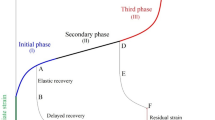Abstract
Numerical modelling is a widely applied technique to study the performance and behavior of various civil engineering structures under various loading conditions. It is particularly advantageous in the case of a typical situation involving complex geometry, uncommon fill materials, very poor ground conditions, extreme environmental loadings, etc. However, the analysis involves certain steps to be followed. This paper summarizes the review of existing design and analysis of reinforced soil structures, numerical modelling requirements for deformation analysis, and illustrations of numerical methods through various live projects. It should be noted that the realistic results from the numerical methods are highly dependent on both correct modelling procedure and close attention to the appropriate input parameters.





Similar content being viewed by others
References
IS 1893 Part1 (2002) Criteria for earthquake resistant design of structures. Bureau of Indian Standards, India
IS 16014 (2018) Mechanically Woven, double—twisted, hexagonal wire mesh gabions, revet mattresses, rockfall netting and other products for civil engineering purposes (Galvanized Steel Wire or Galvanized Steel Wire with Polymer Coating)—Specification, Bureau of Indian Standards, India
IRC 6 (2014) Standard specifications and code of practice for road bridges, Section-II, loads and stresses. Bureau of Indian Standards, India
IRC 34 (2011) Recommendations for road construction in areas affected by water logging, flooding and or salts infestation. Indian Roads Congress, India
IRC 75 (2015) Guidelines for the design of high embankments. Indian Roads Congress, India
IRC 89 (2019) Guidelines for design and construction of river training and control works for road bridges. Indian Roads Congress, India
IRC 113 (2013) Guidelines for the design and construction of geosynthetic reinforced embankments on soft subsoils. Indian Roads Congress, India
IRC SP 116 (2018) Guidelines for design and installation of gabion structures. Indian Roads Congress, India
MoRTH Section 3100 and Section 700, Specifications for road and bridge works. Indian Roads Congress, India.
BS 8006 Part-1 (2016) Code of practice for strengthened/reinforced soils and other fills
FHWA-NHI-10–024 (2009) Design and construction of mechanically stabilized earth walls and reinforced soil slopes. Federal Highway Administration, Washington
Plaxis bv., (2019) PLAXIS 2D—tutorial manual, Netherlands
Plaxis bv., (2019) PLAXIS 2D—Reference manual, Netherlands
Korulla M, Beena KS, Maurya P (2019) Instrumentation for disaster affected reinforced slopes in Uttarakhand, India. Adv Sustain Const Resource Manag, pp 829–838
Gray WG (1984) Comparison of finite difference and finite element methods. Fundamentals of Transport Phenomena in Porous Media, pp 899–952
Funding
None.
Author information
Authors and Affiliations
Corresponding author
Ethics declarations
Conflict of interest
The authors declare that they have no conflict of interest.
Additional information
Publisher's Note
Springer Nature remains neutral with regard to jurisdictional claims in published maps and institutional affiliations.
Rights and permissions
About this article
Cite this article
Korulla, M., Padmaja, G. & Beena, K.S. Numerical Modelling of Reinforced Soil Structures Through Live Projects. Indian Geotech J 52, 1171–1181 (2022). https://doi.org/10.1007/s40098-022-00606-2
Received:
Accepted:
Published:
Issue Date:
DOI: https://doi.org/10.1007/s40098-022-00606-2




